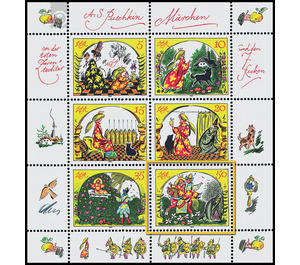Commemorative stamp series - Germany / German Democratic Republic 1984 - 50 Pfennig
Theme: Animals
| Country | Germany / German Democratic Republic |
| Issue Date | 1984 |
| Face Value | 50.00 |
| Color | multi-colored |
| Perforation | K 13 1/2: 13 |
| Printing Type | offset |
| Stamp Type | Postage stamp |
| Item Type | Stamp |
| Chronological Issue Number | 2661 |
| Chronological Chapter | GER-DDR |
| SID | 825023 |
| In 14 Wishlists | |
Fairytale of the Dead Czar's Daughter and the Seven Horses After the fairy tale of the dead Tsar's daughter and the seven warriors, the Ministry of Posts and Telecommunications of the German Democratic Republic publishes in appreciation of A. S. Pushkin six multicolored special postage stamps. The special postage stamps are printed on a miniature sheet with border design. No special first-day cover envelope Special cancellation from November 27, 1984 to January 26, 1985 Tale of the Dead Czar's Daughter and the Seven Wreaths Alexander Sergejewitsch Puschkin (1799 - 1837), the great Russian poet, founded a new genre in Russian fiction with his poetic fairy tales. As a child he had heard the old fairy tales about his nurse Arina Rodionovna Matveeva, a serf-peasant woman. During his banishment in Mikhailovskoe in 1824, he had her told by his old nanny again. He wrote to his brother about it: "In the evening I heard fairy tales, and thus compensated for the shortcomings of my accursed education." What a charm these fairy tales are! Each one is a poem. " Pushkin wrote the fairy tales in verse form, while he did not strictly follow the folk tales heard, he did not create a retelling, but composed the material freely at his discretion. His fairy tales penetrated into the people through the simple, pictorial language and the light, sounding verses, and were passed on like real folktales and mingled with them. In the middle of the 19th century, for example, folklore collections of fairy tales never clearly established what came from the old folk tales and what was borrowed from Pushkin's fairy tale. The "Tale of the Dead Czar's Daughter and the Seven Horses" is very similar to the fairy tale of "Sneewitching". With the same motives and almost the same course of action, it must be regarded as one of the many variants. The fairy tale of "Sneewitching" is one of the most famous European folk tales. Long before the Brothers Grimm added it to their collection of "Children's and Household Tales" in 1812, it had been handed down in writing. Musaeus told it in 1872 in his "folk tales of the Germans" under the title "Richilde" after. Shakespeare used motifs in "Cymbeline". In his 1910 study, Ernst Böklen alone recorded seventy-five variants from Europe. Although the fairy tale hero has different names, the basic attitude is always the same. A narcissistic stepmother who has her beauty confirmed by a magic mirror tries to kill her stepdaughter out of envy of her beauty. This can find shelter in the forest with helpful beings and is brought back to life in the end. Pushkin composed the verse tale in Boldino in 1833 and decorated it considerably. With 530 verses it is almost twice as long as the traditional Russian and Polish folk tales from which Pushkin originated. Synopsis: During the Tsar's absence, the Czarina gets a little daughter, but she dies on his return. One year later, the Czar marries again. The new Czarina has a mirror that can talk and she loves nothing more than to ask him: Dear Mirror, say / Faithful to me answer to the question: / Does not fit me the beauty price? / Am I not so fresh and white, / Hold and lovely of gestures, / That no woman is like me on earth? 5 Pfennig value When everything prepares for the wedding feast of the grown-up Czar's daughter with Prince Jelissej, the Czarina questions her mirror again. She receives the answer: "Beautifully formed are your limbs, / fresh and white is your face, / Yet you are not the most beautiful, / For the most beautiful Tsar child, / The prince as a wife, / Is so lovely of gestures, / That no woman is like her on earth. " The Czarina instructs her maid to tie the Tsar's daughter to a tree in the deep forest so that she will be eaten by the wolves. The maid takes pity and lets the Tsar's daughter run. After a long wandering she finally comes to a house. 10 Pfennig value In it live seven huntsmen, who live from the hunt. She takes care of the household and is recognized as a sister. 15 Pfennig value The Czarina learns through her mirror that the Czar's daughter lives deep in the Eschenwald near the seven knights. She forces the maid, disguised as an old woman, to go to the Tsar's daughter and poison her with an apple. 20 pfennig value The seven wielders lay them in a coffin of crystal, which they tie down in the mountains with iron chains and provided with a grid. Meanwhile, Prince Jelissej seeks her everywhere and questions all people, even the sun and the moon. From the wind he learns where his bride is. The prince rushes to this place to see her again. He smashes the coffin and the Tsar's daughter comes to life. 35-pfennig value At the sight of the returned Czar's daughter, the Tsarina falls down "dead in terror". After she was buried, the wedding could finally take place. 50-penny-value


